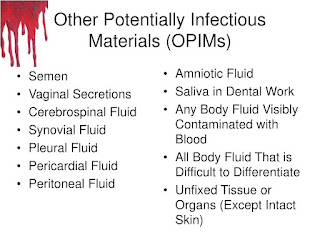Mpox - Vancouver
Infectious Waste
Infectious Waste
Infectious waste is any waste with the presence or the reasonable anticipated presence of blood or other potentially infectious materials on an item or surface. The following are typical materials considered infectious wastes (this is not an all-inclusive list).
There are three types of waste generated in clinical locations and disposed of through the regulated medical waste program. These include:
Clinical personnel can submit an infectious waste pick-up request to EH&S. The infectious waste will be removed by the university's vendor during the next pick-up time. In addition, researchers can submit an infectious waste container request to EH&S.
Infectious Waste Removal Process
Non-sharps regulated medical waste and chemotherapeutic waste bags must be placed in a container that is leak-proof on the sides and bottom, impervious to moisture, and sufficient in strength to prevent puncturing, tearing or bursting during storage. Liquid waste must be placed in containers that are break resistant and tightly lidded. Sharps containers must be puncture resistant, tightly lidded, leak proof and labeled. Cardboard sharps containers are not acceptable for use.
Regulated medical waste and Chemotherapeutic waste containers must be labeled in the following manner by research personnel:
Clinical personnel must be present during the scheduled pick up time. The contactor will not remove the waste if the clinical personnel are not present. Regulated medical waste cannot be placed in the hallway for pickup. The waste must be secure at all times. Overfilled containers will not be removed.
To service waste containers or to obtain regulated waste containers, please contact the EH&S or use the links to submit a request.
Review the Hazardous Waste Management Plan for information concerning allowable amount accumulated, labeling and permitted accumulation time. Additional information can be found under Environmental Compliance.
Bloodborne Pathogens
The RIT Environmental Health and Safety (EH&S) Department has developed a Bloodborne Pathogen Exposure Control Program to ensure the protection of faculty, staff, students, and visitors who put themselves at a reasonable risk of coming into contact with blood and other potentially infectious materials.
Bloodborne pathogens are microorganisms such as viruses or bacteria that are carried in blood and/or bodily fluids and can cause disease in people; including hepatitis B and C and human immunodeficiency virus (HIV). Bloodborne pathogens such as hepatitis B (HBV) and HIV can be transmitted through contact with infected human blood or other potentially infectious body fluids such as:
Employees must sign either: the HBV Shot Declination Form if they do not want to receive the HBV shot series, or if they have previously had the shots; or the HBV Shot Authorization Request Form if they would like to receive the HBV shot series. Please download and complete the appropriate form. Return the signed form to the EH&S Department.
Applicable Regulation29 CFR 1910.1030
ExemptionsRIT is not required to offer the vaccine to workers who provide first aid as a secondary job duty. A secondary job duty is one that is done on an "as needed" basis and is not the individual's primary job function.
Rite Aid To Develop Bloodborne Pathogen Safety Program Following OSHA Probe
As part of an agreement with the U.S. Department of Labor, Rite Aid Corp. Will develop a bloodborne pathogen safety program to better protect retail workers at all of the drugstore chain's locations in New Jersey and New York.
The settlement announced Aug. 21 by the DOL stems from an April 2022 probe launched by the Occupational Safety and Health Administration after a retail employee at a Rite Aid store in Niagara Falls, N.Y., was instructed to clean up spilled blood following a customer injury.
While investigating, OSHA learned that before the incident the employee had not been offered a hepatitis B vaccine and that Rite Aid lacked an appropriate exposure control plan – a violation of federal regulations, the DOL said. As a result, Rite Aid was issued three citations and fined $31,360. The Philadelphia-based corporation initially contested the violations, but later struck a settlement with OSHA calling for an amended $10,000 fine and withdrawal of its notice of contest.
Under the terms of the agreement, Rite Aid is also required to take several remedial actions at its 370 New Jersey and New York stores, including:
The pact also prohibits the company from retaliating against employees who express concerns or provide information about safety issues to managers or to OSHA.
OSHA Regional Administrator Richard Mendelson in New York said the settlement agreement with Rite Aid "will significantly enhance safety for many of the company's employees in hundreds of stores in the metro-area and beyond.
"They have committed to making sure employees at its New Jersey and New York stores are trained and protected by the same safeguards that apply to employees whose job-specific duties require coverage under the bloodborne pathogen standards," he said. "The settlement expands Rite Aid's bloodborne pathogens protections for those employees who could encounter blood or other bodily fluids while working in the front-end retail area of the stores."
Jeffrey Rogoff, regional solicitor of labor in New York, added, "This settlement shows that the U.S. Department of Labor will pursue litigation outcomes that expand and maximize safety and health protections for workers. Here, an incident at one Rite Aid pharmacy led to an agreement in which the company has undertaken enhanced abatement of bloodborne pathogen hazards at all its New York and New Jersey stores."
Asked why the agreement applies only to Rite Aid's locations in New Jersey and New York, a media representative for Rite Aid would only say that "the settlement the parties reached covers the New York and New Jersey stores." Nationwide, the chain has more than 2,300 retail pharmacies across 17 states.
l

Comments
Post a Comment